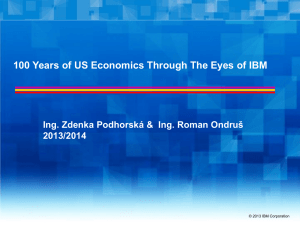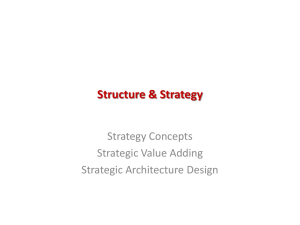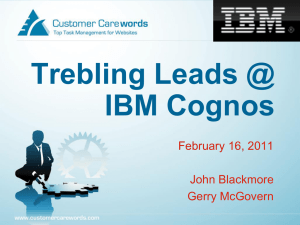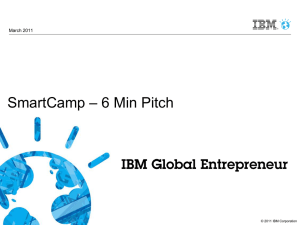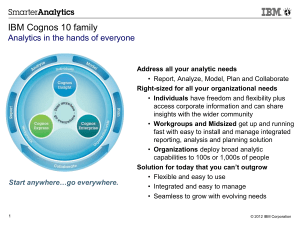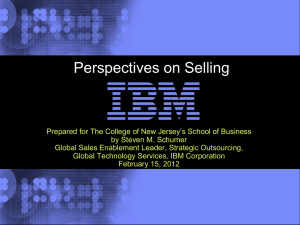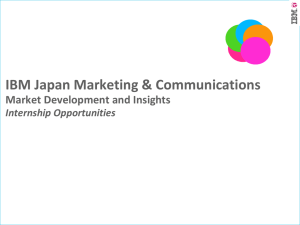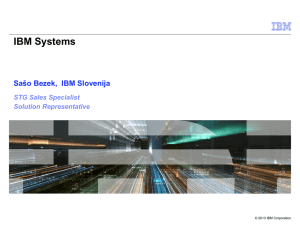Information Management
advertisement
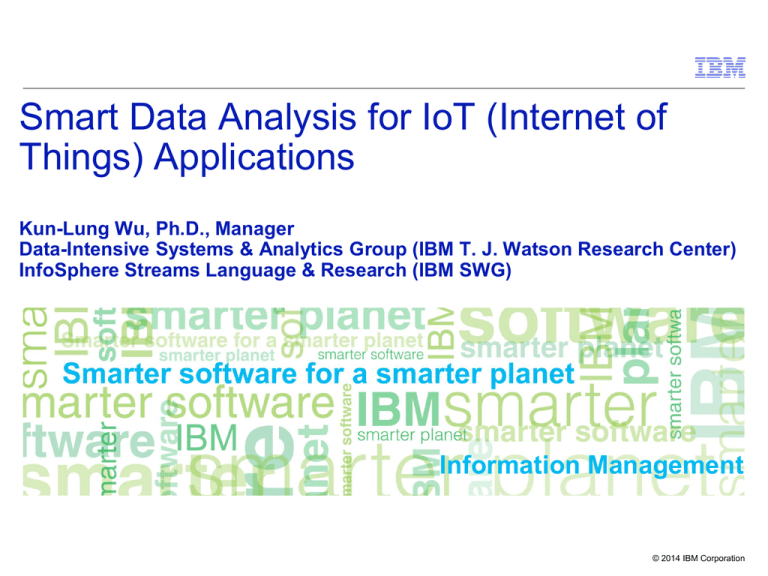
Smart Data Analysis for IoT (Internet of Things) Applications Kun-Lung Wu, Ph.D., Manager Data-Intensive Systems & Analytics Group (IBM T. J. Watson Research Center) InfoSphere Streams Language & Research (IBM SWG) Information Management © 2014 IBM Corporation Information Management As IoT applications become more pervasive, there is a real-time big data explosion Internet of Things Everything Almost anything can be equipped and connected to the Internet Real-Time Big Data Explosion Real-time data analysis is an integral part of many IoT applications They can generate, in real-time, streams and streams of data © 2014 IBM Corporation Information Management Examples of IoT Applications • Smart cities Traffic control, emergency management, etc • Health care Aiding the elderly, ICU alert management, health monitoring via wearable devices, etc • Agriculture & food Precision farming, cold chain management, etc • Industrial applications Manufacturing process monitoring, engine monitoring, etc • Environmental monitoring Water, Waste, Air Quality, etc • Retail applications 3 © 2014 IBM Corporation Information Management What is different in IoT data? There are many extremes There are greater amounts of data Volume Process and act on data more quickly in real time Velocity Use more types data Variety Use uncertain data Veracity © 2014 IBM Corporation Information Management Traditional versus IoT Big Data Traditional Approach IoT Big Data Approach Analyzed Information Available Information Analyze Small Subsets of Information Analyze ALL Available Information Analyze All Information Leverage more of the data being captured © 2014 IBM Corporation Information Management Traditional versus IoT Big Data Traditional Approach Analyzed Information A Small Amount of Carefully Cleansed Information Carefully Cleanse Information Before Any Analysis IoT Big Data Approach Analyzed Information A Very Large Amount of Messy Information Analyze Information As Is, Cleanse As Needed Reduce effort required to leverage data © 2014 IBM Corporation Information Management Traditional versus IoT Big Data Traditional Approach Analyze data AFTER it has been processed and landed in a Warehouse or Mart IoT Big Data Approach Analyze data IN MOTION as it is generated, in real-time Leverage data as it is captured © 2014 IBM Corporation Information Management RE- 8 Standard assumptions Re-think for IoT data analysis Clean and correct data Take advantage of and tolerate uncertainty Transactional guarantees Good enough Normalized, structured data Store data in elemental form Explicit relationships kept Relationships found at query ACID properties Relaxed constraints Centrally managed storage Loosely distributed data Store-and-process Process in motion Reliable hardware Built with full expectation of failures Query, insert, delete with SQL Query, operators, analytics at point of data Reference/context data on disk Reference and context data in memory © 2014 IBM Corporation Information Management From data at rest to data in motion Data at Data in 9 © 2014 IBM Corporation Information Management IBM InfoSphere Streams Delivers Real-Time Analytics For Big Data In Motion Real time delivery ICU Monitoring Algorithmic Trading Volume Terabytes per second Petabytes per day Variety All kinds of data All kinds of analytics Velocity Insights in microseconds Cyber Security Millions of events per second Environment Monitoring Powerful Analytics Government / Law enforcement Telco Churn Prediction Smart Grid Microsecond Latency Traditional / Non-traditional data sources Example Streaming Data Sources: Video, audio, networks, social media © 2014 IBM Corporation Information Management Big Data in Real Time with Stream Processing Filter / Sample Modify Annotate Analyze Fuse Classify Score Windowed Aggregates © 2014 IBM Corporation Information Management InfoSphere Streams: For superior real time analytic processing Streams Processing Language (SPL) built for Streaming applications: Compile groups of operators into single processes: Efficient use of cores Distributed execution Very fast data exchange Can be automatic or tuned Scaled with push of a button Reusable operators Rapid application development Continuous “pipeline” processing Use the data that gives you a competitive advantage: Can handle virtually any data type Use data that is too expensive and time sensitive for traditional approaches Easy to extend: Built in adaptors Users add capability with familiar C++ and Java Easy to manage: Automatic placement Extend applications incrementally without downtime Multi-user / multiple applications 12 Dynamic analysis: Flexible and high performance transport: Programmatically change topology at runtime Create new subscriptions Create new port properties Very low latency High data rates © 2014 IBM Corporation Information Management What Are People Doing With Streams? Stock market Telephony CDR processing Social analysis Churn prediction Impact of weather on securities prices Analyze market data at ultra-low latencies Geomapping Transportation Intelligent traffic management Law Enforcement, Defense & Cyber-Security Real-time multimodal surveillance Situational awareness Cyber security detection Fraud prevention Detecting multi-party fraud Real-time fraud prevention Smart Grid & Energy Transactive control Phasor Monitoring Unit Health & Life Sciences Neonatal ICU monitoring Epidemic early warning system Natural Systems Remote healthcare Wildfire management monitoring Water management 13 e-Science Space weather prediction Detection of transient events Synchrotron atomic research Other Manufacturing Text Analysis Who’s Talking to Whom? ERP for Commodities FPGA Acceleration © 2014 IBM Corporation Information Management Asian telco reduces billing costs and improves customer satisfaction Problem: Call volume increased to the point that batch processing in a warehouse no longer worked 1) Too expensive, 2) too slow, and 3) no capacity left for BI Solution: Real-time mediation and analysis of 8B CDRs per day Data processing time reduced from 12 hrs to 1 sec Hardware cost reduced to 1/8th Further enabled: Proactively addressing issues impacting customer satisfaction, real time offers based on usage 14 © 2014 IBM Corporation Information Management Harnessing the Largest Predictive Focus Group in the World Purpose – Understand public sentiment towards an event: movie trailers – Deeply understand the potential customer profile: gender, occupation, intent to watch – Alter marketing launch plans based on insight Background – 1.1 Billion Tweets analyzed – 5.7 Million blogs/forum posts – 3.5 million messages – Also: Facebook, Google+, Tumblr, Flickr © 2014 IBM Corporation Information Management University of Ontario Institute of Technology (UOIT) Detects Neonatal Patient Symptoms Sooner • Performing real-time analytics using physiological data from neonatal babies • Continuously correlates data from medical monitors to detect subtle changes and alert hospital staff sooner “Helps detect life threatening conditions up to 24 hours sooner” • Early warning gives caregivers the ability to proactively deal with complications © 2014 IBM Corporation 16 Information Management Challenges and opportunities Approach overload – Is there a convergence of approaches? – Is there a “write once, use any technology” approach across tool types Skills to apply techniques – Reduce the skill required? – More people who can be data scientists, developers, and business/domain savvy? Uncertain data – Confidence levels need to follow data and decisions New analytic algorithms – Real time learning and adaptation? – More automation Availability – What does it mean for in-memory systems? – How should disaster recovery work? Cloud – Security of Data – Data movement Data governance, security, and privacy What new problems can we solve? © 2014 IBM Corporation Information Management To Learn more Resources – Streams: streamsDev – IBM Big Data: ibm.com/bigdata – IBMBigDataHub.com – BigDataUniversity.com – Books / analyst papers © 2014 IBM Corporation Information Management Try Stream Processing http://Ibm.co/streamsqs 2 download options! 19 © 2014 IBM Corporation Information Management 20 © 2014 IBM Corporation
